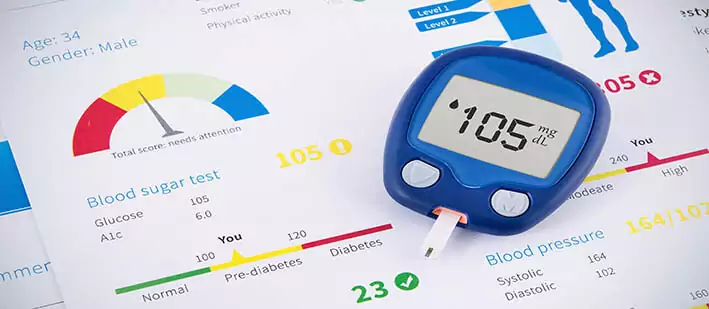
Living With Type 2
What Is the Life Expectancy For Diabetics?
Feb 24, 2017Diabetes is recognized as one of the leading causes of disability and death worldwide. There was a time when Type 2 diabetes was common in people in their late forties and fifties. However, thanks to the easy availability of processed foods, sedentary lifestyles, poor sleep and a host of other unfavorable factors, type 2 diabetes affects millions of young adults throughout the globe today.
A report was commissioned in 2010 by the National Academy on an Aging Society. It showed that diabetes cut off an average of 8.5 years from the lifespan of a regular, diabetic 50-year-old as compared to a 50-year-old without the disease. This data was provided by the Health and Retirement Study, a survey of more than 20,000 Americans over the age of 50, done every two years by the University of Michigan.
Characterized by high blood glucose levels, T2D can be the result of a combination of genes, obesity and an unhealthy lifestyle. If left untreated, diabetes can be life-threatening. Complications of this disease can take a serious toll on a patient’s health and well-being. So, how long do diabetics live, you ask? Does having diabetes shorten one’s life? Let’s address these questions, one by one.
How Long Do Diabetics Live?
Diabetes is a system-wide disorder which is categorized by elevated blood glucose levels. This blood travels throughout the human body and when it is laden with sugar, it damages multiple systems. When the condition is left unchecked or is managed poorly, the lifespan of diabetic patients is reduced due to constant damage.
Early diagnosis and treatment of diabetes for preventing its long-term complications is the best coping strategy. So, don’t ignore your doctor’s advice if you’re pre-diabetic right now. Keep in mind that if you’re at a high risk of developing T2D, a normal meal followed by a professionally done PP blood test is of high priority. It will help in detecting impairment in early phase insulin release, a condition which is, almost, always present in the early stages of type 2 diabetes. But, the sad truth is that depending solely on fasting blood glucose measurement for diagnosis is not sufficient. We may miss out on those individuals who have isolated postprandial hyperglycemia, which is elevated blood glucose levels only post a meal, and normal fasting plasma glucose levels. A research study has compared the diagnostic criteria of the World Health Organisation and American Diabetes Association. It has proven that this is a common occurrence and it doubles mortality risk, since this condition can go undetected for longer periods. Those who want to be extra sure that their blood sugar is always under control should opt for a more elaborate version of the prediabetes tests at home.
Life expectancy of a diabetic patient decreases when Type 2 diabetes has accompanying conditions like:
- Nerve Damage
- Hyperglycemia and Ketoes
- Cardiovascular disease
- High Blood Pressure
- High Cholesterol Levels
- Kidney Damage
- Gum Disease
- Retinopathy
- Digestive Ailments
- Atherosclerosis
Diabetes Life Expectancy
The lifespan of diabetic patients can decrease by 10 to 15 years, according to a report titled ‘Diabetes in the UK 2010 – Key Statistics on Diabetes’. However, the improvements made in diabetic care since then mean that diabetic patients today can live a significantly longer life, with proper T2D management.
The average life expectancy of a type 2 diabetic patient is between 77 to 81 years. However, it is not uncommon for diabetics to live past the age of 85, should they be able to maintain good blood sugar levels and lengthen their lifespan. Bear in mind that the age at which T2D is diagnosed and the combination of risk factors also play a major role here.
The United Kingdom Prospective Diabetes Study (UKPDS) Outcomes Model is a computer simulation model that forecasts the first likely occurrence of major diabetes-related complications, and death, in patients diagnosed with type 2 diabetes (8). According to UKPDS:
If you are a 55-year-old man diagnosed with type 2 diabetes, five years post-diagnosis, your life expectancy can vary between:
13.2 years for a patient who –
- Smokes
- Has systolic blood pressure (SBP) of 180 mmHg
- A total/HDL cholesterol ratio of 8
- An HbA1c of 10%
AND
21.1 years for –
- A non-smoker
- With SBP of 120 mmHg
- A total/HDL cholesterol ratio of 4
- An HbA1c of 6%
Which Is Worse? Type 1 or Type 2?
This is a common question among diabetics and the general populace alike. Type 1 diabetics have it rough since the condition sets in from childhood; and hence live with the condition for longer. With Type 2, while it is detected much later in life, the condition brings with it a host of other complications.
If you have type 1 diabetes, you aren’t able to produce insulin and you’ll have to depend upon insulin every single day for the rest of your life. If you are a type 2 diabetic, over time, your cells will become insulin resistant and insulin that your body does produce finds it exceedingly difficult to control your blood sugar. While type 1s can be diagnosed rather quickly and can start taking action immediately, type 2s can remain undiagnosed for years in which time they would have many health complications.
Type 1 diabetes is extremely difficult and cumbersome to manage – taking insulin every day and eating the right diet at the right time. With type 2 diabetes comes several comorbidities, which are more difficult to manage and may lead to damaging outcomes. Research tells us that type 2 diabetes is more of an inflammatory disease than a result of just insulin resistance. This means that type 2 diabetes has a far reaching and more damaging effect on the body of the sufferer.
In terms of fatalities, type 2 kills more than 3 million people worldwide, while type 1 is responsible for the deaths of around 350,000 people. But then, why has life expectancy been lower for people with type 1 diabetes? Earlier when the life expectancies of the two types of diabetes were compared, it was found that type 2s had a 10-year reduction in life expectancy as compare to almost 20 years for type 1s. But through the years, this gap has been closing. This is due to advancements in medical technology as well progress in the healthcare system.
That said, we believe (and many mainstream doctors agree) that type 2 diabetes can be reversed and you can lead a normal healthy life. To achieve reversal, you need a disciplined and a well-rounded approach that includes diet, lifestyle modifications and stress management. We say “reversal” and not “cure,” because if you go back to your old lifestyle, your condition will come back.
How to Live A Long Life With Diabetes
The most important thing about living with T2D is its constant management. Proper diabetes management goes a long way. The life of a diabetic person can be improved greatly by making a few simple and daily lifestyle changes.
Maintain healthy blood sugar levels
Nothing is worse than fluctuating blood glucose levels. Regular blood glucose tests while fasting and post a meal, both, are important to keep a close check on the numbers.
Monitor your Fasting Insulin Level
This is almost as important as your fasting blood sugar level. The ideal level is between 2 and 4. The higher your level, the less sensitive your cells are to insulin. The more cells refuse to let insulin bring in sugar, the more sugar stays in your blood.
Lose weight
Even losing as little as 5-7 percent of one’s body weight drastically reduces the risk for diabetes-related complications. Intermittent fasting is a fantastic way to achieve weight loss and improve insulin sensitivity. So, start gently but make it a critical part of your arsenal in dealing with diabetes.
There is no substitute for exercise
It helps to lose weight and improves mental health.
Chose the right diabetic diet plan
Give up on grains and sugars. These types of carbs will raise your insulin levels. We highly recommend a Low Carb-High Fat diet (LCHF Diet) for all diabetics.
Stop smoking
Diabetics who smoke are at a higher risk of serious health complications that include diseases of the heart, eyes and the kidneys. They also have poor blood circulation in the legs and feet that can lead to infections and ulcers that are difficult to heal. This may lead to amputation that could have been avoided by just giving up smoking.
Lead a stress-free life
Stress, even everyday stress of missing the train or flight can put a severe strain on the body’s metabolism. Stress activates the fight-or-flight mechanism of the body which is an evolutionary feature of humans. This activation leads to high blood sugar levels that can remain elevated for a long time, leading to long term complications. We’ve explained how stress is bad for diabetics. Practicing stress management techniques like deep relaxation, yoga and meditation go a long way in helping control blood sugar levels by keeping stress at bay.
Sleep well
This advice has been given to us by all and sundry since ages and yet sleep is probably the most underrated of all human functions. Its importance in keeping our body healthy has been researched comprehensively and results suggest that not only is sleep important for rest and repair of the body, it also helps keep diseases and biochemical disorders at bay. Sleep loss can gradually cause insulin resistance which is the precursor to full blown type 2 diabetes.
It is best to reverse type 2 diabetes through lifestyle changes, rather than just focusing on medicines. Let’s not be naive and assume that just because blood sugar levels can be brought to acceptable lab values through medications, no other damage is being done. Research shows that when fasting blood glucose levels are over 80 mg/dl, oxidative damage from diabetes has already begun.
Try natural medicine – A holistic approach towards keeping blood glucose levels stable (with a healthy lifestyle and supplements) may keep unwanted side effects of diabetes medication at bay.
Continuous lab tests are a must to stay at the top of your physical and mental conditions. Diagnosing further complications (which are a result of diabetes) in a timely fashion is, thus, also taken care of.
How long a person can live with type 2 diabetes depends on how well they manage their diabetes. Arm yourself with the knowledge you need to lengthen your lifespan today and live a happy, healthy and long life without letting diabetes affect you.
References:
1. Life Expectancy in a Large Cohort of Type 2 Diabetes Patients Treated in Primary Care (ZODIAC-10)
2. Mortality Trends in Subjects With and Without Diabetes During 33 Years of Follow-up
3. Mortality in adults with and without diabetes in a national cohort of the U.S. population, 1971-1993.
4. Oxidative stress in type 2 diabetes: the role of fasting and postprandial glycaemia
6. Isolated post-challenge hyperglycaemia confirmed as a risk factor for mortality
7. Development of life-expectancy tables for people with type 2 diabetes





